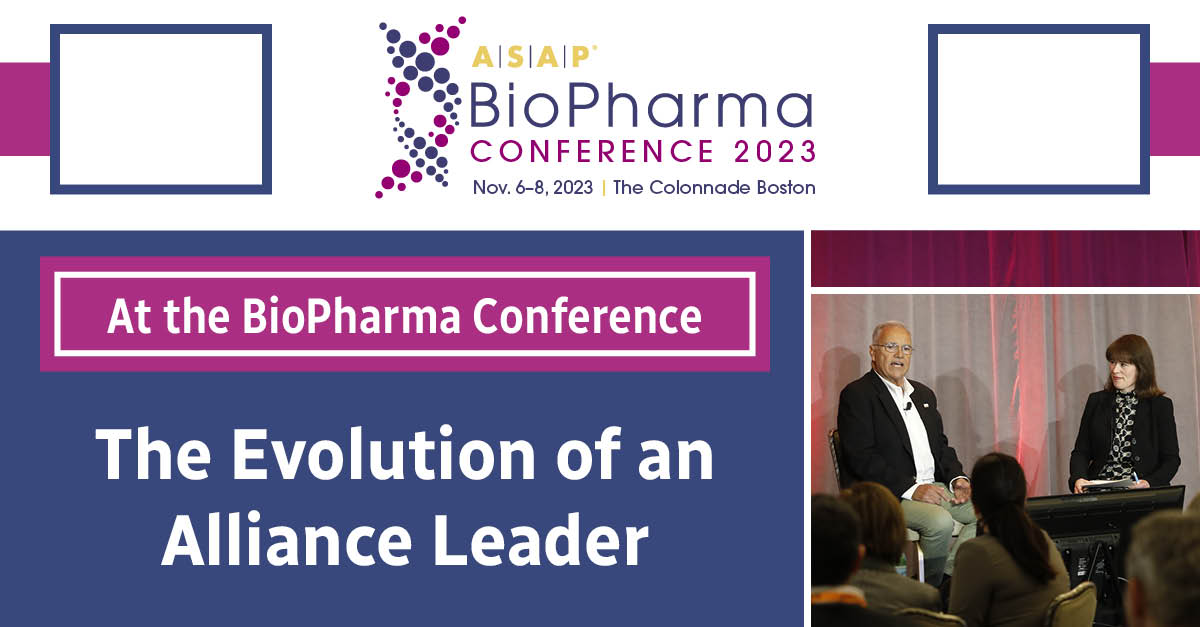The Evolution of an Alliance Leader
With the impending retirement later this month of ASAP president and CEO Michael Leonetti, CSAP, “a key feature of our alliance community” is moving on, ushering in a new era for ASAP. That was the description given by Brooke Paige, CSAP, digital alliance leader at Novartis, as she interviewed Leonetti for the fireside chat “Championing the Profession: Insights from a Pioneer in Alliance Leadership” on the final day of the ASAP BioPharma Conference held Nov. 6–8 in Boston.
Paige and Leonetti have known each other for more than two decades, with Leonetti having hired her while at Boehringer Ingelheim. Before that, he worked in sales, HR, and organizational development, then headed up a business unit overseeing managed care customers. By that time, Boehringer Ingelheim was partnering with other pharma companies, including Abbott, Upjohn, and Pfizer. So Leonetti’s CEO one day told him, “You’re going to do alliances!”
Initially he tried to decline the opportunity, then reasoned that “this is just another sales relationship.” Wrong. “I fell hard and fast,” he said—but luckily found his “rescue plan” in the form of ASAP.
New Cookbooks and Missed Opportunities
He went to his first ASAP meeting in 2002, and initially started learning from “the tech folks” like Cisco and IBM, who had been partnering for a while already and were using scorecards and other forms of assessment and metrics around partnerships. “Why can’t we do it in biopharma?” Leonetti wondered.
As it happens, the first ASAP BioPharma Conference took place in Connecticut in 2004 in a Boehringer Ingelheim auditorium, attended by about 40 people, Leonetti said. “We had to learn the hard way. We didn’t have a cookbook or a textbook. We had to create it ourselves.”
At that time Boehringer had an alliance with Eli Lilly and Company, and it was there that Leonetti met future alliance luminaries Steve Twait, CSAP, and David Thompson, CSAP—both of whom have since moved on, but Thompson serves as ASAP’s board chair and thanked Leonetti in a warm introduction this morning for teaching him some things over the years, principally about “attitude and expectations.”
That positive attitude would be tested over time. Leonetti’s first CEO at Boehringer had “a collaborative mindset,” he said, but a new leader proved quite different. Although partnerships made up roughly 70 percent of the company’s revenue at that time, the new chief was concerned about “splitting the pie” versus growing it. Leonetti tried to explain the role of alliances to the CEO—as well as the success they were having—but came to feel his efforts failed. “I missed that opportunity,” he said. Other CEOs he met over the years, by contrast, saw the value of partnering but thought it was “easy.” Not so much!
What’s the Method in the Madness? Lifelong Learning
Leonetti’s connection with ASAP started over 20 years ago and ended up with stints on the board of directors and, for the last 10 years, as our president and CEO. He still credits the organization with providing frameworks, principles, and best practices to follow in alliances, answering his own internal query that “there’s got to be a method to this madness.”
In his view, ASAP still plays that role, along with being an educational and professional resource for the growing alliance profession.
“Learning is a lifelong obligation,” he told the audience. “It’s what happens here that you’re all a part of. It keeps you ahead of the curve, and helps your people have confidence in you.” As an alliance leader, he added, his approach to colleagues is: “You’re the smartest person—I’m here to remove obstacles. You want to do well, help people be successful, and be competitive.”
Asked for advice to dole out to newer alliance professionals, Leonetti expanded on the learning theme.
“I’m so thrilled you’re here because you’re doing the right thing,” he said. “You’re here to learn. Keep learning! There’s so much richness in this community where we learn from each other. It’s a journey, and you’ll be uncomfortable at times—like the first time you have to advocate for your partner and [someone in your organization] asks, ‘Who signs your paycheck?’ You have to work on it. But keep learning here with your colleagues. Don’t fail like I did—you don’t need to fail!”
What’s Next?
Asked what he sees coming up next in biopharma partnering, Leonetti cited digital alliances, digital therapeutics, GenAI, and platform-based partnerships—all involving “complex technologies.”
“Everybody’s going to become a technology company,” he said, echoing frequent ASAP speaker Jay McBain of Canalys, “so how could you not have a role? We’re going to continue to evolve.”
Looking to his own immediate future, Leonetti predicted that he would be “sitting around relaxing, putting my feet up, playing with my grandkids,” playing golf, and going out on his boat to do some fishing. But he added that he would likely “get bored after four months” and vowed to stay active in ASAP.
“I can’t just leave friends I’ve known for 20 years,” he said. “I’m not saying goodbye—it’s more ‘see you next year.’”
Finally, of ASAP’s future with its next president and CEO, the incoming Nicole Boston, CAE, he said, “You’re in very good hands. I think she’ll bring exciting new concepts to ASAP, with her association management experience, and that’s good. But the heart and soul of this organization is right here in this room.”

